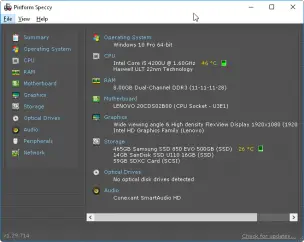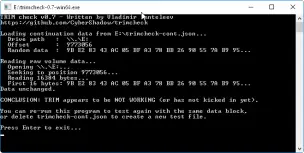Ventura Ultra USB 3.0 SSD Review
Mushkin’s Ventura ultra is the first USB external SSD we’ve had the pleasure to test. The device is a hefty amount larger than a standard flash drive but not enough to make it unwieldy. It’s size does have the potential to block off ports on some systems but are an unfortunate design necessity.
Our Test System and Procedure
 Our test system for USB attached devices is a Thinkpad S1 yoga 2014 edition. The system is running windows 10 x64 pro and is equipped with an Intel xHCI controller. This should make the results comparable to any native Intel USB 3.0 controllers. We’re going to use the same test procedure we do on a sata based drive. I expect lower performance in general due to the 5Gbps limit of USB 3.0 compared to 6Gbps of Sata III.
Our test system for USB attached devices is a Thinkpad S1 yoga 2014 edition. The system is running windows 10 x64 pro and is equipped with an Intel xHCI controller. This should make the results comparable to any native Intel USB 3.0 controllers. We’re going to use the same test procedure we do on a sata based drive. I expect lower performance in general due to the 5Gbps limit of USB 3.0 compared to 6Gbps of Sata III.
The Ventura ultra
The drive is packaged in a simple blister pack as seems standard for Mushkin’s products. The package indicates some basic details of the drive. Taking a look at the table below we can see all of the published specs on the drive. The published specs are a bit slimmer than normal for an SSD but being a USB device this isn’t abnormal. A few details do stand out such as the use of an SF-2281 controller from LSI. We’ve seen this controller before in testing the OWC accelsior although there isn’t a raid controller involved this time. This controller does offer data compression and we’ll explore that some during testing.
Inside the Ventura
One unique feature we have with the Ventura Ultra is it’s assembly uses standard Phillips screws. We take advantage of this to take a peek inside something we don’t normally get to do. We see two separate PCB’s which is surprising but sensible upon examination. One board carries the USB bridge and some other components as well as a plug for the second larger board. The larger board carries 4 nand packages as well as the SF-2281 itself. The nand packages are assembled by Mushkin themselves and are unfortunately unidentifiable beyond being Tier-1 MLC nand.
ATTO
Like always we start off with ATTO Disk Benchmark. ATTO is provided by ATTO technology a designer of fiber channel and other high performance storage devices. Performance is fairly impressive with a quick increase in speeds till the 128/256k transfer size is reached. The peak 430Mb write and 440Mb read speeds are effectively the limits of the USB3 interface. One interesting thing we see appear is a sudden drop in read speed at the 64Mb transfer size. This sudden drop seems to be thermal throttling as the package approaches 46*C which appears to be a limit.
Trimcheck
Trim is a requirement for maintaining the performance of any modern SSD. It works by informing a drive which blocks are no longer in use by the file system. This allows them to be flushed during garbage collection. As SSD’s have program and erase as separate operations, this helps maintain performance by avoiding degradation as blocks are used. Unfortunately due to the use of the USB bridge to translate to SATA controller trim appears non functional. There are ways to restore performance(such as a quick format) without trim however these usually come at the cost of the data stored on the drive. This may not be an issue depending on your use case.
Crystal Disk Mark 5.1.2 x64
Up next we have Crystal Disk Mark another canned benchmark and a very popular one. We use it in our reviews of lower performance memory products as it’s inclusive of both sequential and random data. Unlike ATTO Crystal Disk Mark defaults to incompressible data which is what we use by default. We see writes coming in at a meager 139.7 MB/s lower than expected after the numbers we saw in ATTO. These results however are unsurprising knowing that ATTO is susceptible to compression. We see fairly healthy read results of 404. MB/s approaching the limit of the interface. Taking a peek at the 0-fill data shows that compression is working as intended.
Anvil
Probably the single most comprehensive canned benchmark is Anvil’s storage utilities. Anvil allows us to which tests multiple queue depths and access types all with a single button press. Anvil corroborates what we saw in crystal disk mark. Sequential numbers are bit lower than I expected coming in at 132.13 write and 378.84 read. Taking a peek at atto it reported much more impressive numbers for the 4mb transfer size likely due to compression. Overall performance isn’t bad however considering the form factor.
AS SSD
AS SSD utilizes incompressible data exclusively in its testing and also reports access times. Access times something missing from most of our other tests and give a feel for a drives responsiveness. These come back at an acceptable for a USB device .364 and .495 milliseconds for reads and writes respectively. Write performance under AS SSD takes a heavy toll with the sequential test relying on a 16Mb transfer size. The use of such a large transfer size appears to cause the drive to throttle early on. AS SSD also includes a convenient file copy benchmark showing us what we can expect when moving a variety of data types around on the drive itself.
PCmark8
PCmark 8 includes a variety of real world scenarios using predetermined runs of real world software of which it records the time required to complete them and reports them. Individual times are reported per application in addition these are all used to calculate a total throughput. The Ventura Ultra weighs in at 4628, the lowest score we’ve seen on an SSD so far. Considering the drives limited by both USB as an interface and been crunched into a stick form factor I’m still impressed by this.
Consistency Test
Our custom consistency test bombards the drive with 4k random writes at a queue depth of 32 This test continues until it reaches what is referred to as “steady state” at this point we observe how the controller and nand act under their worst case scenario(dirty nand and no time to recover). This test is run for two hours which is more than sufficient to push a drive like the Ventura Ultra into steady state. The results here are interesting to say the least. The Ventura holds on till about 1800 seconds before having consistent swings between a ~200iop floor and ~4000iop ceiling. These are good results considering the form factor although the drive is the victim of heat for most of this test.
Pricing and Final Thoughts
The Ventura Ultra is our first look at USB attached SSD’s. Compared to other USB devices it’s performance is astounding for mixed workloads although it does so at the expense of size and heat. The Ventura Ultra combines high end MLC memory with a proper SSD controller to create an attractive package. For the use case of a portable OS platform or a drive to edit content from on the go it’s the only USB device we’ve reviews I could even consider to suggest. Mushkin has developed a product that was built using the best available technology when it was designed and holds true as an excellent device even today. Anyone in need of a portable OS or media editing volume can find the Ventura Ultra on here on amazon






